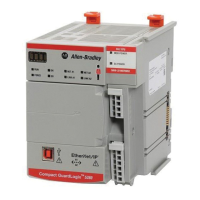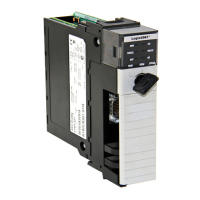Rockwell Automation Publication MOTION-RM003I-EN-P - February 2018 347
Axis Fault Bits
Usage Access T Data Type Default Min Max Semantics of Values
Required - All Get/GSV
1
T DWORD - - - Bitmap
0 = PhysicalAxisFault
1 = ModuleFault
2 = ConfigurationFault
3 = GroupFault
4 = MotionFault
5 = GuardFault
6 = InitializationFault
7 = APRFault
8 = SafetyFault
9...31 = Reserved
1
Direct Tag access is supported. Bit names shown are used as data type member names in the Logix Designer application.
The Axis Fault Bits attribute is a collection of basic fault types associated with the
axis. Each valid axis fault type is assigned a bit in this word. Any fault condition
associated with a given fault type will result in the setting of the appropriate fault
bit.
Each bit in the Axis Fault Bits attribute represents a roll-up of the associated fault
types. One or more faults of a given fault type result in the associated bit of the
Axis Fault Bits attribute being set.
This table provides descriptions of the Axis Fault Bits:
Bit Name Description
0 Physical Axis Fault
If the Physical Axis Fault bit is set, it indicates that one or more fault conditions have been
reported by the physical axis. The specific fault conditions can then be determined through
access to the axis data type specific fault attributes of the associated physical axis.
For Servo axis data types, Physical Axis Faults map to the Servo Faults attribute. For Servo
Drive axis data types Physical Axis Faults map to the Drive Faults attribute. For CIP Drive
axis data types Physical Axis Faults map to the standard CIP Axis Faults attribute or
manufacturer specific CIP Axis Faults
1 Module Fault
Th
e Module Fault bit attribute is set when one or more faults have occurred related to the
motion module associated with the selected axis. The specific fault conditions can then be
determined through access to the Module Fault attribute of the associated axis. Usually a
module fault impacts all axes associated with the motion module. A module fault
generally results in the shutdown of all associated axes. Reconfiguration of the motion
module is required to recover from a module fault condition.
2
Configuration
Fault
The Configuration Fault bit is set when an update operation targeting an axis configuration
attribute of an associated motion module has failed. Specific information concerning the
Configuration Fault may be found in the Attribute Error Code and Attribute Error ID
attributes associated with the motion module.
3 Group Fault
The Group Fault bit attribute is set when one or more faults have occurred related to the
motion group associated with the selected axis. The specific fault conditions can then be
determined through access to the Group Fault attribute of the associated motion group.
Usually a group fault impacts all axes associated with the motion group. A group fault
generally results in the shutdown of all associated axes. Reconfiguration of the entire
motion subsystem is required to recover from a group fault condition.
